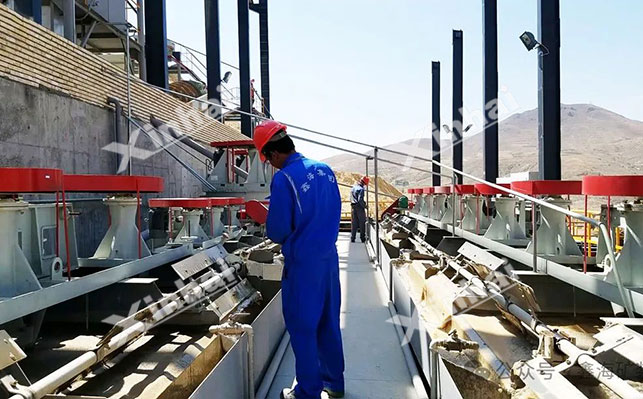In the mineral processing industry, oxidized lead-zinc ore typically exhibits a flotation recovery rate that is 5%-12% lower than that of sulfide ores due to its strong hydrophilicity and complex mineral embedding characteristics. Our technical team, with 20 years of experience in mineral processing EPC services, has successfully improved client recovery rates to industry-leading levels through process innovation. This article systematically analyzes the key technological pathways:
1.1 Intelligent Desliming Process
Utilizing a "hydraulic cyclone + high-frequency vibrating screen" dual-stage desliming system can remove over 80% of -10μm fine slime. A project in Yunnan demonstrated that after desliming, the grade of zinc concentrate increased by 2.3 percentage points, with reagent consumption reduced by 18%.
1.2 pH Precision Control Technology
A dynamic monitoring system for pulp pH was established, controlling the lead flotation stage at 8.5-9.2 and raising the zinc flotation stage to 10.5-11.3 through segmented lime (CaO) addition. With an automatic dosing device, pH fluctuations can be maintained within ±0.3.
2.1 Stepwise Flotation Strategy for Lead and Zinc
A three-stage process design of "lead roughing - lead scavenging - zinc activation" was implemented, activating suppressed zinc minerals by adding ferrous sulfate (300-500g/t). Following application in a Xinjiang plant, zinc recovery increased by 6.8%.
2.2 Breakthrough in Heavy Flotation Combined Process
Adding a spiral chute re-selection system in the flotation tailings section allows for the recovery of coarse oxidized zinc minerals with a liberation degree over 85%. Compared to single flotation processes, overall recovery rates improved by 4%-5%, with energy consumption reduced by 22%.

3.1 Application of GY-101 Effective Collector
The new chelating collector enhances selectivity for oxidized zinc minerals by 40%, maintaining stable collecting ability in pH environments of 10-12. Industrial tests showed a recovery rate increase of 5.2% when the zinc concentrate grade reached 42%.
3.2 Synergistic Control Technology for Depressants
Using a composite depressant ("sodium hexametaphosphate + sodium humate" in a 3:1 ratio), mud suppression efficiency improved by 35%, while sodium silicate usage was reduced by 40%. Coupled with an online concentration monitoring system, dynamic and precise reagent addition is achieved.
4.1 Pyrite Activation System
A dual activator system using "ferrous sulfate + oxalic acid" (in a 2:1 ratio) increased pyrite flotation recovery to 78%, effectively reducing losses of lead-zinc minerals. In a project in Laos, lead recovery surpassed the technical bottleneck of 72%.
4.2 Strengthening Closed-loop Circulation
Three-dimensional fluid simulation optimized flotation machine configuration, establishing a closed-loop system of "roughing - three-stage cleaning - three-stage scavenging." Results indicated that the lead grade of concentrates stabilized above 55%, with operational recovery rates increasing by 3%-5%.
Employing MLA mineral liberation analysis systems allowed precise measurement of:
Embedding particle size of oxidized lead-zinc minerals (80% concentrated in the range of 10-45μm)
Main gangue mineral types (quartz accounting for >60%)
Mineral symbiotic relationships (60% zinc minerals co-existing with limonite)
Based on big data, an optimization model for process parameters was established, guiding grinding fineness adjustments to achieve -200 mesh at 85%-90%, enhancing liberation degree to 91.3%.
Biodegradable Collectors: The new DZ-03 series reagent reduces COD values by 62%, with zero toxic substances added.
Wastewater Recycling System: Achieved a water reuse rate of 90%, reducing fresh water consumption to 0.8m³ per ton of ore.
Tailings Dry Stacking Technology: Utilizing high-efficiency deep cone thickeners keeps tailings moisture content below 18%.
For each project, we provide:
Laboratory Small-scale Tests (initial schemes provided within 3-5 working days)
Continuous Expansion Tests (to verify process stability)
Three-dimensional Digital Factory Design (saving construction costs by 15%-20%)
Intelligent Control System Deployment (real-time monitoring of over 200 process parameters)
After applying this scheme to a Central Asia project with a capacity of 2000t/d oxidized lead-zinc ore:
Lead concentrate grade increased from 48% to 53%
Zinc comprehensive recovery rate exceeded 68%
Mineral processing costs reduced by $1.2/t ore
Project investment payback period shortened to 3.2 years